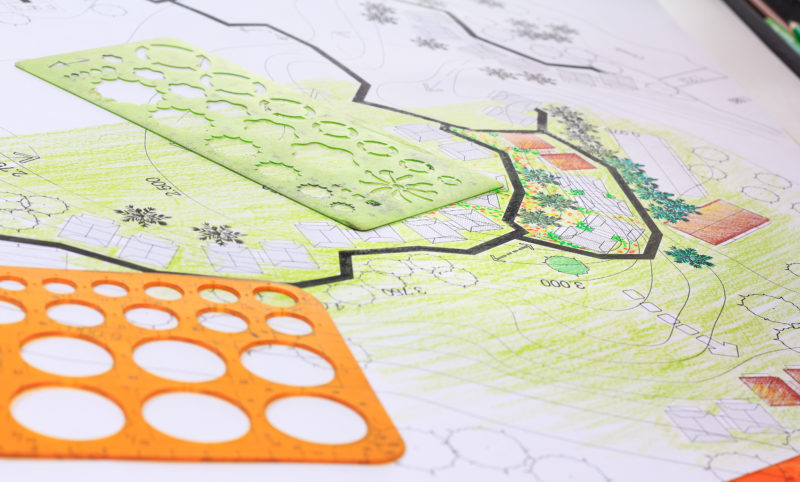
Land Connections–Creating Healthy Landscapes

Healthy landscapes help create healthy communities. A healthy landscape is an outdoor space designed to promote the health and well-being of people and the environment. There are many social, ecological, and environmental benefits associated with healthy landscapes, including improving quality of life and mitigating environmental impacts.
The Landscape Institute provides five principles that are believed to create healthy places (1):
- Healthy places improve air, water, and soil quality. They include incorporating measures that help us to either adapt to climate change or mitigate its impact on us.
- Healthy places help overcome health inequalities and promote healthy lifestyles.
- Healthy places relax people, increase social interaction and reduce anti-social behavior, isolation and stress.
- Healthy places optimize opportunities for working, learning, and development.
- Healthy places are restorative, uplifting, and healing for both physical and mental health conditions.
Well-planned, healthy landscapes are important to improving physical and mental health conditions. Landscape architects are leaders in the design and creation of healthy spaces for present and future generations, and given society is just emerging from a historic pandemic, their societal role is even more important than ever.
The Role of Landscape Architects in Creating Healthy Landscapes
Landscape architects are responsible for designing and planning public open spaces, from parks to hospital courtyards, and play a key role in incorporating and applying design strategies that promote healthy lifestyles. Creating healthy landscapes requires a creative approach of blending aesthetic, form, and function that not only adheres to the above principles, but also make these spaces attractive, accessible, and inclusive.
Landscape architecture involves critical thinking and problem solving that considers many aspects of the project, including existing site conditions, budget, community-defined programs, local materials and available sources, stakeholders, and unique goals. Landscape architects have the growing expertise of illuminating the best design solutions based on site-specific project opportunities and constraints. They weave into the design fabric, principles that guide the development of space, including those that promote the health and well-being of people and the environment.

There is a growing need to create healthy landscapes and landscape architects have the opportunity to act upon creative ideas that allow landscapes to support health outcomes and increase well-being.
Example of Design Strategies to Create Healthy Landscapes
There are several design techniques that assist in the creation of high-quality landscapes that promote good health and well-being. One technique is to incorporate a walking loop with outdoor fitness equipment throughout the path to encourage physical activity and social engagement. Walking loops can be constructed with various surfaces like pour-in-place rubber surfacing to minimize physical impact and make it easier to walk on, which benefits older populations and those with physical disabilities in particular. Intentional color choices for the surfacing can also be used to increase visibility, contextual contrast, and prominence, so a path is highlighted within a space.
Another design technique to help create healthy landscapes is to optimize opportunities for education and learning. This includes providing flexible or permanent spaces for outdoor classrooms and interpretive and educational signage about the environment. Examples might include historical, cultural, and environmental context associated with a public copen space or facility. Incorporating opportunities to learn within open spaces is valuable for creating healthy landscapes because education in natural environments enhances the personal development of children and adults (2).
Providing spaces for both reflection and refuge can also contribute to healthy landscapes. Healing gardens, labyrinths, lined tree grove spaces, and quiet, secluded seating areas, are examples of design programs that allow people to relax and reset the mind. Studies have shown that access to nature can have positive effects on mood and promotes recovery from stress and attention fatigue (3). Access to nature can enhance people’s sense of tranquility and can have beneficial, restorative effects to the health and well-being of all age groups.

A well-planned, healthy landscape can improve air, water, and soil quality through the implementation of strategies that mitigate environmental impacts. Reducing air pollution, water use, and the effects of urban heat islands are sustainable design efforts that can promote healthier and cleaner environments. Adding native plants and trees, using regenerative energy, and incorporating smart water-saving irrigation strategies are some additional ways to create healthy landscapes. Another extension of this is to source non-toxic, local, and recycled materials to help conserve resources and minimize environmental impacts. Sustainable design strategies are important to creating healthy landscapes because they not only promote a healthy environment, but also sustain them for many generations to come.
Lastly, choosing an appropriate plant palette can provide a wide variety of benefits to the ecosystem and people. Using plants historically found in the region, can encourage and restore local biodiversity of plants, wildlife, and habitats where they have been damaged, which can indirectly impact human health. Also, considering allergy ratings and low toxicity of plant species is important to promoting good health and well-being of people and their pets. Similarly, adding community vegetable gardens can promote healthy eating, particularly in food deserts, create opportunities for social engagement within a neighborhood, and provide education to the public about nutrition and agriculture.

These are just a few ideas and strategies that landscape architects can consider and incorporate when creating healthy landscapes. Whether these are implemented in a small, private backyard space or a public regional park, every one can foster healthier landscapes and lifestyles. As landscape architects, we have the capacity and responsibility to do more than simply designing attractive, functional landscapes. We should create healthy spaces that promote the long-term health and well-being of people, animals, and the environment whenever and wherever possible.
References
1. https://landscapewpstorage01.blob.core.windows.net/www-landscapeinstitute-org/2013/11/Public-Health-and-Landscape_FINAL_single-page.pdf Public Health and Landscape: Creating Healthy Places by the Landscape Institute, 2013.
2. http://www.sd-commission.org.uk/data/files/publications/Outdoor_environments_and_health.pdf Health, Place and Nature: How Outdoor Environments Influence Health and Wellbeing: A Knowledge Base by Sustainable Development Commission, 2008.
3. http://publications.naturalengland.org.uk/publication/6692039286587392 Microeconomic Evidence for the Benefits of Investment in the Environment by Natural England, 2014.
About the Author

Ting Li is a Landscape Designer at O’Dell Engineering. She has over 8 years of experience in the industry and holds a Master of Landscape Architecture from the University of Georgia. Ting is passionate about parks and recreation and loves to see the community enjoying the outdoor spaces she helps design.
Learn More
For previous Land Connections articles, click here.
For information on joining the O’Dell Engineering team, click here.
To see our landscape architecture project experience, click here.
Go Back